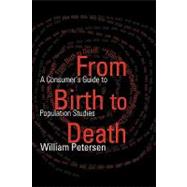From Birth to Death: A Consumer's Guide to Population Studies
, by Petersen,William- ISBN: 9780765800060 | 0765800063
- Cover: Hardcover
- Copyright: 5/31/2000
Demography is a measurement for the study of human populations, especially with reference to size, density, distribution, and vital statistics. From Birth to Death is a detailed analysis of how population statistics are collected in the United States, particularly by the Bureau of the Census, and of the errors and other flaws typically found in such data. Petersen has here built a body of material garnered from his extensive command of demography and also from relevant works on archaeology, anthropology, economics, and sociology, incorporating it into an up-to-date discussion of current problems. In the volume's opening chapter, Petersen sets out the fundamentals of demography and reviews the current proposal to use sampling in the next census. In his discussion on age and sex structure, he cites a number of historical examples of how ignoring this fundamental element led to false conclusions. Chapter 3 explores race and ethnicity and the dilemmas inherent in the necessarily ambiguous definitions of these categories. Chapter 4, on the physiological and social determinants of fertility, analyzes the problems of career women who postpone having children to ages when risks of failure become significant. In chapter 5, Petersen, in examining mortality, emphasizes both the stupendous decline of world death rates and the new difficulties this creates, and follows with a section on health, addressing the developing expectation that everyone has a right to an expanding denotation of "wellness." Chapter 7, on prehistoric and primitive populations, explains that anthropological data on population are neither abundant nor reliable. In chapter 8, the author reviews the two most prominent population theories � Malthus and the fertility transition. In chapter 9, on forecasts, Petersen asks why predictions of future population size, though very often completely wrong, are nevertheless in great demand. In chapter 10, he discusses the pros and cons of state intervention in the control of fertility and efforts to cut family size in less developed countries and their unclear results. The book concludes with a summary chapter. A principal topic of this book is the relative accuracy of population statistics, the degree to which one should accept the data as published. The main focus is on the United States and especially on the Bureau of the Census, but general points are sometimes illustrated with examples of how data of other countries should be evaluated. Not only demographers and statisticians but also anyone interested in public policy and its statistical underpinning will find this work both interesting and useful. William Petersen, Robert Lazarus Professor of Social Demography Emeritus at Ohio State University, widely is known throughout the profession as a leading demographer.







